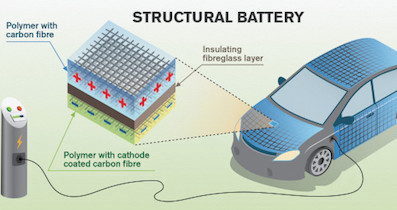 Cleanzine: your weekly cleaning and hygiene industry newsletter 10th July 2025 Issue no. 1170
Cleanzine: your weekly cleaning and hygiene industry newsletter 10th July 2025 Issue no. 1170
Your industry news - first
The original and best - for over 20 years!
We strongly recommend viewing Cleanzine full size in your web browser. Click our masthead above to visit our website version.
Technology: Will news that carbon fibre can store energy in a vehicle body impact on cleaning machines?
 Ed: I came across something this week that I'm thinking could potentially change the way we manufacture/use batteries for/in cleaning machines. Not being a battery expert, I may have gone off kilter; however, the technology's interesting so I thought I'd share it. I'd love to receive your comments on whether you think it could be viable.
Ed: I came across something this week that I'm thinking could potentially change the way we manufacture/use batteries for/in cleaning machines. Not being a battery expert, I may have gone off kilter; however, the technology's interesting so I thought I'd share it. I'd love to receive your comments on whether you think it could be viable.
A study led by Chalmers University of Technology, Sweden, has shown that carbon fibres can work as battery electrodes, storing energy directly. This opens up new opportunities for structural batteries, where the carbon fibre becomes part of the energy system. The researchers' vision is of vehicles where a large part of the body of the vehicle consists of structural lithium ion batteries.
Multi-functional carbon fibre can work as battery electrodes and load-bearing material consecutively. They say that the use of this type of multifunctional material can contribute to a significant weight-reduction in the vehicle in which it is used (the researchers were looking at aircraft and cars) - a key challenge for electrification.
Passenger aircraft need to be much lighter than they are today in order to be powered by electricity. A reduction in weight is also very important for vehicles in order to extend the driving distance per battery charge.
 Leif Asp, Professor of Material and Computational Mechanics at Chalmers University of Technology, conducts research into the ability of carbon fibres to perform more tasks than simply to act as a reinforcing material. They can store energy, for example.
Leif Asp, Professor of Material and Computational Mechanics at Chalmers University of Technology, conducts research into the ability of carbon fibres to perform more tasks than simply to act as a reinforcing material. They can store energy, for example.
"A car body would then be not simply a load-bearing element, but also act as a battery," he says. "It will also be possible to use the carbon fibre for other purposes such as harvesting kinetic energy, for sensors or for conductors of both energy and data. If all these functions were part of a car or aircraft body, this could reduce the weight by up to 50%."
The Professor headed up a multidisciplinary group of researchers who recently published a study on how the microstructure of carbon fibres affects their electrochemical properties - that is, their ability to operate as electrodes in a lithium-ion battery. So far this has been an unexplored research field.
The researchers studied the microstructure of different types of commercially available carbon fibres. They discovered that carbon fibres with small and poorly oriented crystals have good electrochemical properties but a lower stiffness in relative terms. If you compare this with carbon fibres that have large, highly oriented crystals, they have greater stiffness, but the electrochemical properties are too low for use in structural batteries.
"We now know how multifunctional carbon fibres should be manufactured to attain a high-energy storage capacity, while also ensuring sufficient stiffness," he says. "A slight reduction in stiffness is not a problem for many applications such as cars. The market is currently dominated by expensive carbon fibre composites whose stiffness is tailored to aircraft use. There is therefore some potential here for carbon fibre manufacturers to extend their utilisation."
In the study the types of carbon fibre with good electrochemical properties had a slightly higher stiffness than steel, whereas the types whose electrochemical properties were poor are just over twice as rigid as steel.
The researchers are collaborating with both the automotive and aviation industries. The Professor explains that for the aviation industry, it may be necessary to increase the thickness of carbon fibre composites, to compensate for the reduced stiffness of structural batteries. This would, in turn, also increase their energy storage capacity.
"The key is to optimise vehicles at system level - based on the weight, strength, stiffness and electrochemical properties. That is something of a new way of thinking for the automotive sector, which is more used to optimising individual components. Structural batteries may perhaps not become as efficient as traditional batteries, but since they have a structural load-bearing capability, very large gains can be made at system level.
"In addition, the lower energy density of structural batteries would make them safer than standard batteries, especially as they would also not contain any volatile substances."
The research has been funded by Vinnova, the Swedish Energy Agency, the Swedish Research Council and Alistore European Research Institute.
Image: Courtesy of Yen Strandqvist - Increased energy efficiency with multi-functional carbon fibre
The researchers work with structural lithium ion batteries where the negative electrodes are made of carbon fibre and the positive electrodes are made of cathode-coated carbon fibre. In the picture, the battery is charged, which means the negative electrode is filled with positively charged lithium ions.
Image: Courtesy of Johan Bodell - Leif Asp with a bobbin of carbon fibre yarn. The electrodes in a structural lithium ion battery consist of carbon fibre yarn arranged in a grid in a polymer. Every length of yarn consists of 24,000 individual carbon fibres.
18th October 2018







